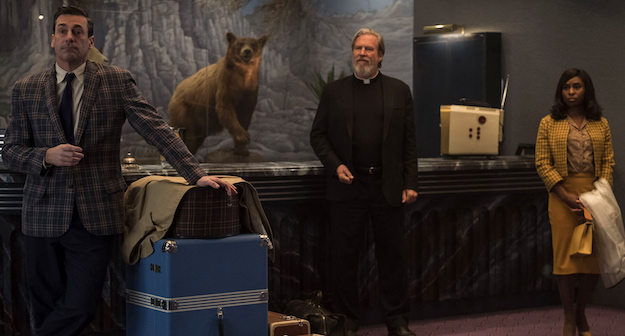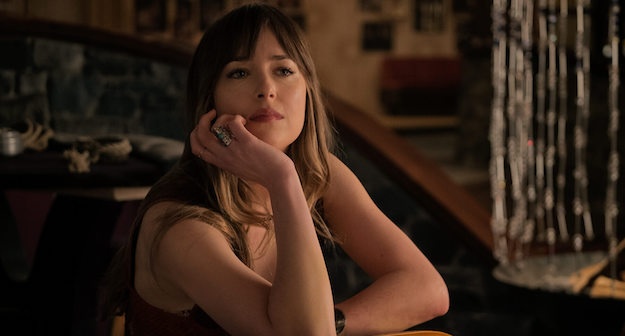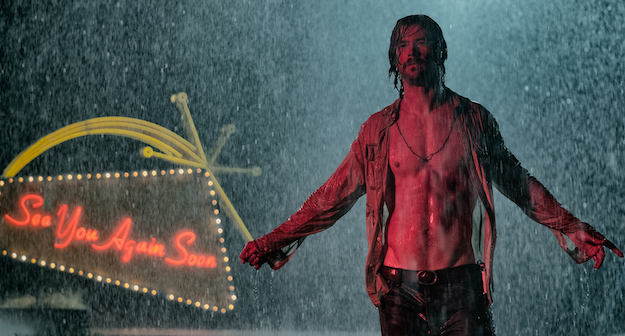Film of the Week: Bad Times at the El Royale

Drew Goddard’s Bad Times at the El Royale is an exceedingly clever film, although it’s not quite clever enough; it’s a brisk number, but at two hours 21 minutes it’s definitely not brisk enough. It’s one of those films that dare critics to give away anything about its twisty plot and devious construction; as it starts to unpack its surprises early on, it puts a reviewer in that position where all you can really do is hold up a big “SPOILER WARNING” sign at the start, and forge ahead as best you can.
There isn’t really anything that surprising about Goddard’s follow-up to 2012’s The Cabin in the Woods, except how extremely old-fashioned it is—not to say theatrical. The film opens in a hotel room, at some point in the 1950s: we see a fedora’ed man (you might recognize Nick Offerman under the brim) stagger in from a rainy night, do some extended and nefarious business that provides the setup for what follows, then promptly drop out of the narrative. Goddard and DP Seamus McGarvey shoot this head-on, the room displayed before us like a realist stage set: we feel as if we’re positioned in a central stalls seat, one of the best in the house, although we suspect that the show may be one of the creakiest in town.
To be fair, Bad Times wears its creakiness like a badge of pride. There’s nothing in its panoply of twists that’s really surprising, and the film coasts cheerfully on its recognition factor: this character is obviously that historical figure, this subplot obviously refers to that urban myth, this plot point is clearly a nod to that movie. But things fit together neatly enough, and the neatness is a pleasure in itself: the film is all about seeing how a doll’s house fits together.
As you may guess from the poster, Bad Times is about a handful of characters who check in at a hotel in the late ’60s—and, as you’ll quickly gather, the real protagonist in the film is the hotel itself, in all its tarnished retro glory, intricately and exuberantly designed by Martin Whist, with splendor and ruin inhabiting the same space. As a rule, I’m rather allergic to the cliché by which a city or a building is deemed a “character” in a movie, but it’s probably unavoidable here, not only because the El Royale imposes itself so forcefully as a space but also because its existence is freighted with as much backstory as the characters.
After the prologue, we jump 10 years ahead to a morning at the hotel, as a young African-American woman (Cynthia Erivo) and an elderly priest (Jeff Bridges) exchange cautious but affable pleasantries, having just arrived. The El Royale, we learn, lies bang on the border of California and Nevada, with a stripe dividing the place in two; guests can decide which state they prefer to stay in. It’s an amusing premise, although Goddard’s script doesn’t do a great deal with it, and I would have though it was a highly original one, although it turns out that this was also the selling point of the real-life Cal-Neva Lodge, a resort with a glamorously checkered history. The real Cal-Neva’s history is so juicy, in fact, that it seems almost wasteful to squander it on a 141-minute drama: it surely deserves to be the basis of a whole TV miniseries, or a 900-page James Ellroy conspiracy novel.

The El Royale’s glory days are far behind it: it lost its gambling license, and now there’s no reason for anyone to visit. So in the gilded but desolate lobby, with no staff in sight, the film’s guests arrive: Darlene Sweet (Erivo), a soul singer eking out a precarious career; Father Daniel Flynn (Bridges), an elderly priest who appears to be suffering from dementia-derived memory lapses; Emily Summerspring (Dakota Johnson), a hippie whose hard-boiled toughness suggests a serious aversion to peace and flowers; and Laramie Seymour Sullivan (Jon Hamm), a brash, obnoxious, floridly garrulous vacuum cleaner salesman from the South. It’s largely on account of Hamm’s speeches at the start that Bad Times runs quite as long as it does; it’s a very drawn-out first act.
I use the term “first act” advisedly, because the lobby sequence again wears its theatricality on its sleeve. For much of the opening stretch, it’s as if we’re watching a filmed performance of a stage thriller in which characters get to walk on, introduce themselves, set up our expectations, and do a little fancy acting in the process: you expect to hear a round of applause from the back stalls every time someone famous walks in at the front door. This setup encourages a certain thespian flamboyance: this is perhaps the first time we’ve seen Hamm live up to his name. But then the characters here are themselves acting. Hardly anyone is quite what they seem—and stifle a yawn if you must, but seriously, Goddard does actually ring some enjoyable changes on this most predictable formula.
When the trailers first appeared, the film smacked suspiciously—as quite a few social media commentators noted—of all those knowing ensemble pieces that started to appear in the wake of Pulp Fiction. If ever a film looked 20 years out of date, this was surely it—but then, where’s the dividing line between out-of-date and knowingly retro? In fact, this film’s staginess makes it resemble quite another Tarantino movie: The Hateful Eight (or as I prefer to think of it, A Fistful of Dullards). As several critics noted, The Hateful Eight was basically a snowbound Western take on Agatha Christie; it worked from a sort of And There Were None premise, in which characters were dispatched one by one on a single set, a log-cabin variant on the English country house drawing room that was the default Christie locale for murder and its explication. In terms of being bound by a set and by a locale cut off from the outside world—by a storm, failed phone connections and automobile sabotage—El Royale is very Christie, or The Hateful Eight without Stetsons.
But it’s also a variant on Goddard’s previous, superior film, the fiendishly inventive and self-referential meta-chiller The Cabin in the Woods. That film turned out to be a “trick box” movie: its single location proved, in the outrageous finale, to contain a whole system of hidden boxes; this time, however, Goddard doesn’t make us wait too long to reveal that the architecture of the El Royale is as well-furnished with secret compartments as the guests’ luggage.
Goddard tells his story room by room, taking us in chapters into this characters’ individual backstories, and revealing who they are, how they got here, and why here of all places. The narrative jumps backwards, forwards, and sideways, artfully positioning its interruptions, and slotting together its pieces in adroit tessellation. Ducking in and out of the action is a character whose mysterious absences somewhat thread the whole thing together: the hotel’s nervous, fragile young manager/barman/bellhop factotum Miles Miller (Lewis Pullman), its only remaining staff member, whose cringing awkwardness puts him somewhat in the lineage of Dennis Weaver’s “night man” in Touch of Evil.
There are two other characters I haven’t mentioned, and they’re connected: an ambivalent waif (Cailee Spaeny) and someone played by Chris Hemsworth, who makes a swaggering last act appearance, which shouldn’t come as any surprise, since he takes central place on the poster. He’s the movie’s weak spot: while the actor sends himself up as much as when playing Thor, it’s a showboating performance entirely predicated on Hemsworth’s beefcake glamour, and it comes across as altogether bogus, not least because the idea of a sun-kissed, swaggering pin-up version of Charles Manson doesn’t somehow seem ideal for our times.

Without giving away too much more, a couple of elements do bear discussing. One is the acting—because this is very much a deluxe vitrine for prestige performance. And some of the cast absolutely shine. If you like your Hamm ripe and well-seasoned, suffice to say he has a lot of fun. And Lewis Pullman, whom I hadn’t seen before—he was recently in Lean on Pete and Battle of the Sexes—is someone worth keeping an eye on, revealing dimensions to his confused nebbish character that you genuinely don’t see coming. Bridges is as good as you’d expect, affably sneaky and finding surprise reserves of poignancy in a character that seems ostensibly like a spare card from a Clue game.
But the film’s secret weapon, and the absolute reason for not passing it up is Cynthia Erivo. A Grammy and Tony Award–winning British actress and singer best known from the stage musical of The Color Purple (she’s also in Steve McQueen’s Widows), Erivo is a revelation here: sly, witty, and over the course of the narrative, able to make Darlene the one character who might have stepped out of real life rather than another movie. Darlene has a painful moment early on in a flashback to her humiliation, as a backing singer. Her tormentor is a record producer apparently based on Phil Spector, but for some reason with an English accent (and the real unexplained mystery is why Goddard thought that dubious Quebecois wunderkind Xavier Dolan was right for the role).
Apart from singing her way magnificently through a swathe of the ’60s soul jukebox repertoire, Erivo persuades us of Darlene’s need to survive, and conveys a sense of the tawdry, brutal showbiz economics behind the gloss of the entertainment business to which El Royale is a ruined temple. She and Bridges also make a superb double act: there’s a delicious setpiece of complicity between them, as Darlene and the priest use a song’s percussive beat to disguise a bit of surreptitious business.
The other curious thing is the way it uses American history. Throughout the film, maybe because I missed an explicit signal, I kept puzzling over exactly when it was set. The design, the costumes, and most of the music—notably that Spector-ish session—tell us we’re in the early ’60s, but the allusion to the Sharon Tate murder and the soundtrack presence of Deep Purple’s “Hush” signal the end of the decade. I wasn’t entirely convinced that all the characters and events really belonged in the same time frame, but one shouldn’t be too pedantic. The moment at which El Royale screams most insistently, “This is absolutely and seriously a film about 1960s America!” comes towards the end, when Goddard unveils another character’s surprise history—suddenly cutting to a flashback sequence that, in the middle of a story largely enacted in claustrophobic interiors, is a brief but elaborate setpiece that looks as it cost as much as the rest of the film put together. It’s not entirely convincing, though, as a real marker of time and place. The whole film feels as if the 1960s has been compressed into one gilded presentation case. Narratively speaking, it’s a best-of-the-’60s jukebox, but it has a few hit tunes among the duds, and some enjoyable surprise B-sides that you really don’t expect Goddard to spin.
Jonathan Romney is a contributing editor to Film Comment and writes its Film of the Week column. He is a member of the London Film Critics Circle.







